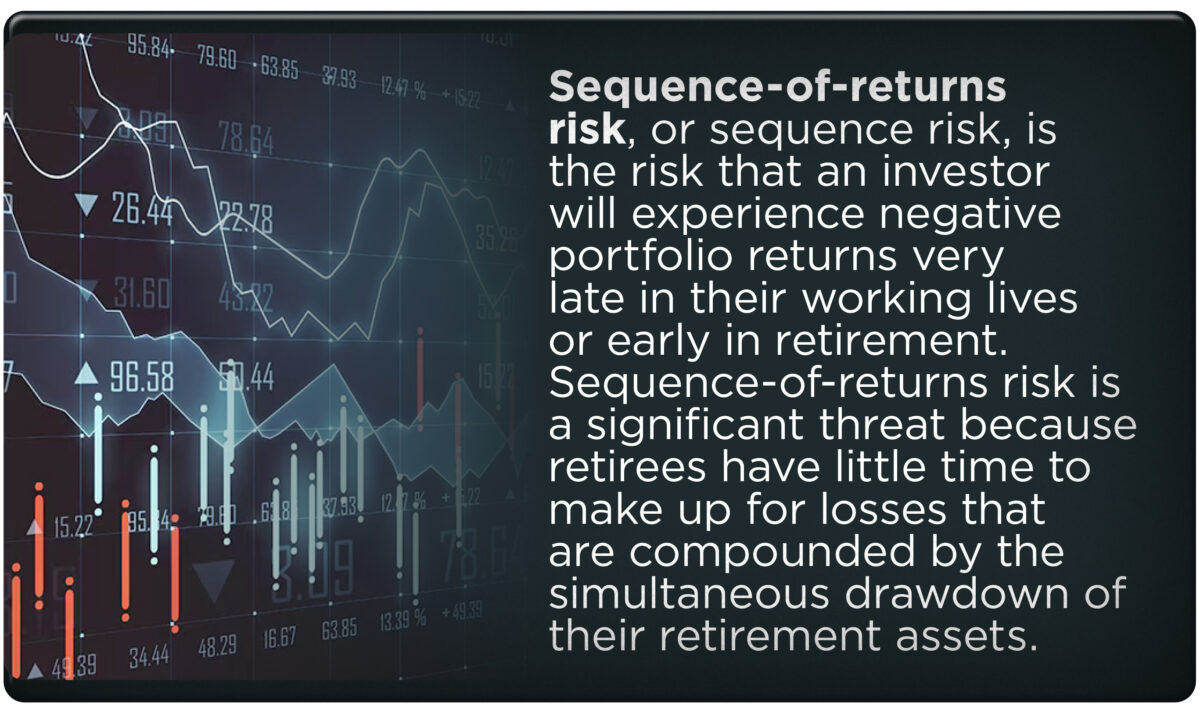Help clients keep sequence-of-returns risk from sinking their retirement

Since the start of 2022, we’ve seen rampant volatility in markets and an overall decline of more than 12% in the S&P 500. Although this situation highlights the potential impact of sequence-of-returns risk, I’m still not sure that it receives enough attention.
Sequence-of-returns risk refers to the possibility of a steep market downturn when a person is either early in retirement or on the verge of retiring — and this risk can cause lasting damage to the value of an investment portfolio.
Withdrawing money to cover living expenses when a portfolio is significantly down might mean it won’t adequately recover even after markets rebound. So, retirees who rely on consistent returns over time could be forced to reduce their standard of living or take greater investment risks as they attempt to make up lost ground.
However, one option that can effectively hedge against sequence-of-returns risk — and enable advisors to provide their clients with additional confidence and peace of mind — is a well-designed permanent life insurance policy. Using the permanent life insurance policy to supplement retirement needs, especially in down markets, can prove to be beneficial in meeting a client’s needs. In addition, because the monies taken from the life insurance are tax-free, the client can withdraw less than they would need to withdraw from traditional investments or even a qualified plan.
Policy provisions
Part of the reason why sequence-of-returns risk can be so concerning is its unpredictability. Although the occasional significant downturn is inevitable due to the cyclical nature of markets, it’s nearly impossible to forecast exactly when one will occur.
That’s why having an instrument such as permanent life insurance can be appealing and reassuring. But it doesn’t fit every situation and shouldn’t be thought of as an investment. Instead of buying life insurance only to offset investment risks, there should be a specific need for the death benefit. LIMRA studies have shown that as many as 46% of Americans have put off purchasing the life insurance coverage they know they need.
Permanent life insurance policies have a cash-value component that can be maximized through overfunding, and this is where the compounding and tax advantages come into play. The key is to design the policy to avoid the current Modified Endowment Contract Rules per Tax Code Section 7702 and, effective January 2022, these limits were lessened.
To fully leverage the potential of a permanent policy, it pays to start early. If a person begins thinking in their mid-60s about trying to manage sequence-of-returns risk, the opportunity may have been lost. But if someone buys a policy in their early to mid-40s, it could accumulate enough cash value to be used for this purpose and provide a substantial and effective death benefit as well.
Keep in mind that the majority of the policy’s costs are taken in the first seven to 10 years of a permanent policy. These include components such as the acquisition cost, taxes and mortality charges. However, once the “breakeven point” is reached after about a decade, compounding growth starts to kick in. Additionally, it’s critical to build in protections and management tools to avoid the negative ramifications of a policy lapse.
Lack of awareness
I find that investors tend to lack awareness of sequence-of-returns risk, and even advisors may not fully realize the key role permanent insurance can play in combating it. Although it’s common to hear about tax-now, tax-later and tax-free as the three main categories of investment vehicles for retirement, I believe many advisors focus primarily on the tax-now aspect.
They might also help manage the tax-later component because their clients are involved with company retirement plans such as 401(k)s and other qualified plans. But few advisors talk much about the tax-free element — and when they do, it’s usually in reference to Roth IRAs.
Roth IRAs are great opportunities for clients; however, life insurance at its core has the same basic characteristics of a Roth IRA: after-tax money growing tax-deferred, along with the ability to pull it out on a tax-free basis. But there are two major benefits on the life insurance side.
First, if the person dies prematurely, their retirement plan can be fully funded through a tax-free life insurance policy. With a Roth IRA, you might have a goal to reach $500,000 and a plan to get there in 15 years. But if you happen to die in year five, you unfortunately wouldn’t reach that goal. Whereas with a permanent policy, there could be a $500,000 death benefit for your family.
Second, unlike Roth IRAs, life insurance doesn’t have significant limits based on income. You could potentially put $1 million a year in a policy if you qualified for the corresponding death benefit amount. So I believe that diversification of asset classes and taxable income in retirement are key concepts that advisors could discuss more.
Economic downturn
Before last year, many financial advisors who are currently practicing had never seen a down market. It was much easier to be successful in the previous decade-long bull market because no matter what an advisor did, their clients would likely see significant portfolio gains. The current economic downturn has spawned a greater interest in permanent policies, partly because advisors now realize they must conduct more significant planning to help clients reach their financial and retirement goals.
Additionally, in an environment where it’s now harder to show clients the results they want to see, advisors face greater pressure to employ a holistic, personalized approach or risk losing those clients to competitors. Advisors who are fiduciaries must also respect the legal obligation to look out for a client’s best interest.
Under the circumstances, advisors should consider incorporating elements into financial planning that they perhaps didn’t think about when the market was constantly going up. In some cases, permanent life insurance could be an important piece of that puzzle.
At the end of the day, a permanent life insurance policy is an economic instrument that can offer instant, tax-free liquidity to families and businesses at a relatively low cost.
The internal rate of return for a permanent policy at life expectancy generally ranges from 4% to 6%. That’s a reasonable price to pay for providing a family or business with an amount of money that can solve many potential problems. Combined with the cash accumulation aspect, a properly structured permanent life insurance policy is an instrument that should be considered for most clients’ overall financial plans.
Keep in mind that the policy must fit and make sense. There’s also the underwriting component that dictates what the IRR is. If someone is healthy enough to qualify for a preferred rate, the potential death benefits of permanent insurance are greater than if the person only qualifies for a standard or substandard rate. Ironically, for a permanent life policy with a focus on accumulating cash value, underwriting is less impactful on the long-term growth.
These are all important discussions to have with clients as advisors consider how a permanent policy can help hedge against sequence-of-returns risk while providing life insurance for their loved ones.






Want to attract young clients? Learn to speak emoji 🧠 😃 💸
Several major insurers post disappointing numbers even while annuity sales soar
Advisor News
- Americans increasingly worried about new tariffs, worsening inflation
- As tariffs roil market, separate ‘signal from the noise’
- Investors worried about outliving assets
- Essential insights a financial advisor needs to grow their practice
- Goldman Sachs survey identifies top threats to insurer investments
More Advisor NewsAnnuity News
- AM Best Comments on the Credit Ratings of Talcott Financial Group Ltd.’s Subsidiaries Following Announced Reinsurance Transaction With Japan Post Insurance Co., Ltd.
- Globe Life Inc. (NYSE: GL) is a Stock Spotlight on 4/1
- Sammons Financial Group “Goes Digital” in Annuity Transfers
- Somerset Reinsurance Announces the Appointment of Danish Iqbal as CEO
- Majesco Announces Participation in LIMRA 2025: Showcasing Cutting-Edge Innovations in Insurance Technology
More Annuity NewsHealth/Employee Benefits News
- Findings from Montana State University Update Understanding of Managed Care (Public Health Insurance and Special Education Enrollment): Managed Care
- Mental health remains in the forefront 5 years after pandemic
- Proxy Statement (Form DEF 14A)
- Idaho Senate approves Medicaid budget
- John Oliver sued by health care boss
More Health/Employee Benefits NewsLife Insurance News
- Exemption Application under Investment Company Act (Form 40-APP/A)
- Annual Report 2024
- Revised Proxy Soliciting Materials (Form DEFR14A)
- Proxy Statement (Form DEF 14A)
- Exemption Application under Investment Company Act (Form 40-APP/A)
More Life Insurance News